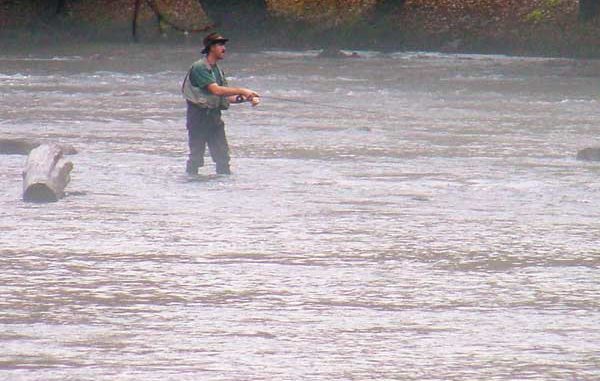
Winter comes to the mountains in muted shades of gray, green and brown.
Except for evergreens, trees have been stripped of their leaves, leaving only bare, twiggy branches. It’s a stark and different kind of beauty here in the winter.
Trout streams run clear and cold, and, sadly, at record lows.
The hot, rainless summer that stretched too far into the fall was not kind to high-country streams. Throughout the mountains, in the Great Smoky Mountains National Park and in the forests, streams that normally gush this time of the year merely trickle.
It’ll be a winter of low water, fewer and smaller fish. We wonder if it will ever be the same again.
“Streams are so low the fish can see you get out of your car a half-mile away,” said one veteran mountain angler.
Winter weather forecasts have been unanimous in only one aspect — uncertainty. Even the usually reliable woolly worm was ambiguous this year in its prediction.
So winter 2007-2008 in the mountains will either be cold and snowy or warm and dry. Science can be so precise at times.
What we can expect for certain are bitterly cold, windy days with a few warm, gloriously sunny days thrown in for good measure.
Whatever the weather brings, one thing is certain — trout streams will be waiting. The fishing will be good as always, depending upon your own definition of good.
Trout must eat regardless of the weather. And true trout fishers must fish regardless of the weather.
To get results in the winter, fishing techniques must adapt to the weather and to the fish. Trout are less likely to move when the water is extremely cold (40 degrees or lower), so feeding lanes will be much more narrow.
The amount of time fishing one spot should be doubled, even tripled. Fish an area thoroughly, move a few feet, and continue casting, using the roll cast to get best results.
Jason Cole, co-owner of Smoky Mountain Fly Fishing in Cherokee, fishes throughout the winter. He’s caught fish during cold, rainy days and when the snow was pouring down.
“It depends on what you can stand,” he said.
The fish will bite regardless.
Cole avoids nearby park streams in the winter.
“It’s tough fishing,” he said.
Instead, he fishes the delayed-harvest waters of the Nantahala River in Swain County and the Tuckasegee River in Jackson County.
Big waters are more dependable, and these big waters are well stocked.
The lower the water temperature, Cole said, the more lethargic the fish.
Flies have to be placed as close to the trout as possible. Mostly, Cole said, he fishes with small midges, small caddis flies, Blue Winged-Olives and Woolly Boogers.
The midges, he said, do especially well at the delayed-harvest streams.
Leaders usually are 9 feet, or less frequently, 7 ½ feet, with 6X or 7X tippets. He often uses a tandem rig, a No. 18 Blue-Winged-Olive on top, and a No. 24 midge tied on an 18-inch tippet as a dropper.
Shawn Buckner of Hunter Banks Co. fly-fishing outfitter in Asheville, said there are only two ways to go in the winter —big, big, big, or small, small, small.
Most of the dry flies he uses are sizes 22 to 18; midges run even smaller, 26 to 18. But when he fishes with a Woolly Booger, he jumps to sizes 8 and 6.
“I either dead-drift or strip them,” he said.
Buckner will alternate between stripping the big fly fast or slow until he gets results. He also strips the Woolly Booger through currents.
“Sometimes the fish will stack up in the currents to feed,” he said.
If the day is sunny, he said, the best places to fish are the sunny spots on a stream. Trout like their creature comforts, too.
When water is low, Buckner resorts to a long reach, using 9-foot leaders with 6X or 7X tippets.
“Trout are very spooky in low water,” he said.
Here are Cole’s and Buckner’s recommendations for winter flies:
• Dry flies: No. 22 to 18 Blue-Winged Olive; No. 26 to 18 gray, black or olive Midge; No. 18 to 16 olive Elk Hair Caddis, No. 20 to 18 Griffith’s Gnat and a No. 18 to 16 parachute Adams.
• Nymphs: No. 20 t0 18 Pheasant Tail, No. 20 to 16 Hare’s Ear, No. 18 to 16 Prince, No. 20 to 14 Copper John, No. 12 to 10 pink or brown San Juan Worm and a No. 8 to 6 brown, black, olive or chartreuse Woolly Booger.
These flies will be effective until major hatches emerge during the spring.




Be the first to comment